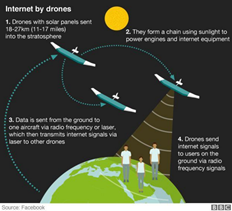...
Facebook aims to build a network of laser-beaming drones that will tightly circle known black-spots. Facebook drones (Aquila) fly for 3 months, operate 60Kft – 90Kft (above planes), launched by helium balloons (drone weighs 880lbs), circle a 2 mile radius. "The whole structure is 142ft (43m) wide but weighs less than a Toyota Prius," Mr Parikh explains. The aim is to build a fleet of the drones with radio transmitters fitted underneath to beam data across a 100 mile (160km) diameter zone below. (see http://www.bbc.com/news/technology-34780127). Drones communicate with ground and one another via lasers that use little power and are high speed. The drones can be up to 11km apart so the accuracy requires hitting a dime (18mm diameter) at 11 miles with both source and destination moving and temperature changes of nearly 200 degrees at 27km above the earth.
Once these atmospheric satellites are up there, there’s a wide range of possible applications. Facebook is obviously interested in internet connectivity, but mapping, meteorology, global positioning, rapid response to disasters and wildfires, and a whole slew of other scientific and military applications are also possible. (Read: Facebook creates Internet.org alliance to reduce price of mobile data plans to 1% of current price.)
Internet.org a Facebook-led initiative reaches 2/3 of world without reliable internet connection. The team is exploring a variety of technologies, including high-altitude long-endurance planes, satellites and lasers. Criticised by activists in both the developed and developing world for only linking users to a walled-garden version of the internet. Internet.org customers can access, for free, selected services such as Facebook, Wikipedia, weather, job listings and government info. But they cannot access the open web through the same service.
...


